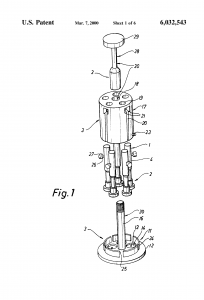Blog
Amending a Claim to Narrow the Scope of a Sub-Assembly Triggered Prosecution History Estoppel for the Whole Assembly
 EMD Millipore Corp. v. AllPure Tech., Inc., ___F.3d___ (Fed. Cir. Sept. 29, 2014) (PROST, O'Malley, Hughes)
EMD Millipore Corp. v. AllPure Tech., Inc., ___F.3d___ (Fed. Cir. Sept. 29, 2014) (PROST, O'Malley, Hughes)
Federal Circuit affirmed a grant of summary judgment of non-infringement, finding that AllPure did not literally infringe U.S. Patent No 6,032,543 and that prosecution history estoppel prevented Millipore from asserting the doctrine of equivalents.
Technology
Millipore's '543 patent claims a device for introducing or withdrawing a fluid sample from a container without contaminating the fluid. The device claims a "removable, replaceable transfer member . . . comprising a holder, a seal . . ., [and] a hypodermic needle" where the seal has a bellows-shaped first end and a self-sealing second end. AllPure's TAKEONE device contains all of the described parts. When disassembled, all of the TAKEONE transfer member components are removable and replaceable.
Literal Infringement
The district court found that disassembly of a transfer member did not qualify as removable. Millipore appealed the grant of summary judgment, arguing that, when disassembled, all components of the TAKEONE transfer member are removed even if they are no longer physically attached. The argument failed. The Federal Circuit found that if a transfer member does not exist when the device is disassembled, then no removable transfer member exists to literally infringe The part removed must have all of the components intact to qualify.
Doctrine of Equivalents
The Federal Circuit held that prosecution history estoppel barred Millipore from arguing infringement under the doctrine of equivalents.
Patent history estoppel applies where an applicant files an amendment narrowing the scope of a claim "to avoid the prior art, or otherwise to address a specific concern . . . that arguably would have rendered the claimed subject matter unpatentable." Warner-Jenkinson Co. v. Hilton Davis Chem. Co., 520 U.S. 17, 30-31 (1997). A narrowing amendment substantially related to a question of patentability gives rise to a presumption that prosecution history estoppel applies. Festo Corp. v. Shoketsu Kinzoku Kogyo Kabushiki Co., 344 F.3d 1359, 1366 (Fed. Cir. 2003) (en banc). The patentee then bears the burden of rebutting that presumption.
During prosecution of the '543 patent, Millipore added the requirement that the seal have a bellows-shaped first end and a self-sealing second end to make the claim "allowable and distinguishable over the cited references." The amendment also removed the highlighted language from the phrase "whereas the transfer member . . . is removable for replacement thereof after use." Millipore argued that the removed language broadened the claim and thus prosecution history estoppel cannot apply.
The Federal Circuit Disagreed. Despite eliminating "after use," Millipore added the limitation that the seal have ends with distinct elements. The court went further and stated that the amendment "narrows the seal limitation, which in turn narrows the transfer member limitation." Thus, a presumption of prosecution history estoppel applied to the entire transfer member structure and not just the seal component. Since Millipore failed to rebut the presumption, estoppel bars arguments under the doctrine of equivalents.
The opinions expressed are those of the authors on the date noted above and do not necessarily reflect the views of Fish & Richardson P.C., any other of its lawyers, its clients, or any of its or their respective affiliates. This post is for general information purposes only and is not intended to be and should not be taken as legal advice. No attorney-client relationship is formed.